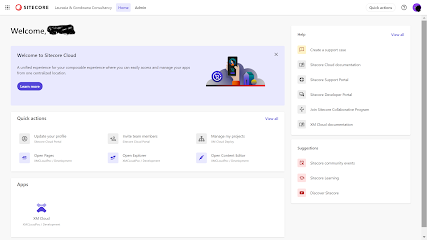Migrating Your Sitecore JSS App to Content SDK: A Complete Guide
As Sitecore continues its evolution toward a fully composable and cloud-native architecture, the Content SDK for XM Cloud marks a significant shift from the legacy JSS SDK. The Content SDK simplifies development, enhances performance, and introduces modern patterns for integrating Sitecore content into front-end applications.
In my previous blog post on the Sitecore XM Cloud Content SDK, I discussed the key differences between the JSS SDK and the Content SDK, along with some of the new concepts introduced in the Content SDK.
In today's blog, I'll walk you through how you can smoothly migrate your project to the Content SDK.
Prerequisites
Before you begin, make sure to:
-
Upgrade your existing app to JSS 22.8.
-
Review the Content SDK changelog to understand major updates.
-
Note that any customizations in your app may require additional migration effort.
-
Identify templates and add-ons used (
nextjs,nextjs-xmcloud,nextjs-sxa,nextjs-multisite) from your package.json file.
Key Changes in the Content SDK
-
Page Editor Only: Experience Editor is no longer available.
-
Centralized Configuration Files:
-
sitecore.config.tsfor app configuration. -
sitecore.cli.config.tsfor CLI configuration.
-
-
New API:
SitecoreClientreplaces old REST/GraphQL services. -
Middleware Handling:
defineMiddlewarereplaces middleware plugins. -
Component Handling:
component-mapreplacescomponentBuilder.
Update Application Dependencies
To update your application dependencies:
-
In your existing app’s package.json, make the following changes:
-
Replace
"@sitecore-jss/sitecore-jss-nextjs"with"@sitecore-content-sdk/nextjs", and update all references accordingly. -
Delete the
"@sitecore-jss/sitecore-jss-cli"dependency. -
Delete the
"@sitecore-jss/sitecore-jss-dev-tools"dependency.
-
-
Install the dependencies: npm install
Create a Template Content SDK App
To create a new Next.js Content SDK application:
-
Run the following command in your terminal:
-
Use the same prerendering mode (SSG or SSR) as your current app.
-
This new template app will serve as your reference for migration.
Update the Next.js Template Files in Your Existing App
Update Configurations
Follow these steps to update your JSS app configuration:
-
Copy the
sitecore.config.tsfile from your template app to your existing app. -
Replace all imports of config from
temp/configand use the newsitecore.config.tsfile.
Example:should be replaced with
-
A new page parameter has been added to
SitecoreContext.
To support this, set theapiparameter to usescConfig.apiand include thepageparameter in the following files:-
[[...path]].tsx -
500.tsx -
404.tsx
Update the code as shown below:
-
Update Environment Variables
Refactor Components and Interfaces
Several files in your Next.js app need adjustments. Refactor components, interfaces, and utilities to align with the new Content SDK structure.
-
Copy
src/components/SitecoreStyles.tsxfrom your template app into the same folder in your existing JSS app. -
In
Layout.tsx, import it as follows:
Update References
-
SitecoreContext→SitecoreProvider
Interfaces
-
SitecoreContextProps→SitecoreProviderProps -
SitecoreContextState→SitecoreProviderState -
SitecoreContextReactContext→SitecoreProviderReactContext -
WithSitecoreContextOptions→WithSitecoreOptions -
WithSitecoreContextProps→WithSitecoreProps -
WithSitecoreContextHocProps→WithSitecoreHocProps
Higher-Order Components
-
useSitecoreContext()→useSitecore() -
withSitecoreContext()→withSitecore()
Properties
-
context→page -
updateSitecoreContext→updatePage -
sitecoreContext→page
Methods
-
getServerSideProps/getStaticProps→getComponentServerProps
Update Service References and Imports
Final Clean-Up
Remove all obsolete or replaced code and files as per the official documentation.
This includes legacy GraphQL, dictionary, layout, page-props, and middleware utilities now managed by the Content SDK.
Finally, ensure you:
-
Resolve all errors and warnings during migration.
-
Enable debug logging for Content SDK to identify any runtime issues.
Conclusion
Migrating from the JSS SDK to the Content SDK is a necessary step toward leveraging the full power of XM Cloud.
The new SDK simplifies configuration, reduces dependency complexity, and offers improved integration with the XM Cloud ecosystem.
While the migration process involves several structural updates, following this guide step by step will help you transition smoothly and ensure your application is ready for the modern Sitecore experience.




Comments
Post a Comment